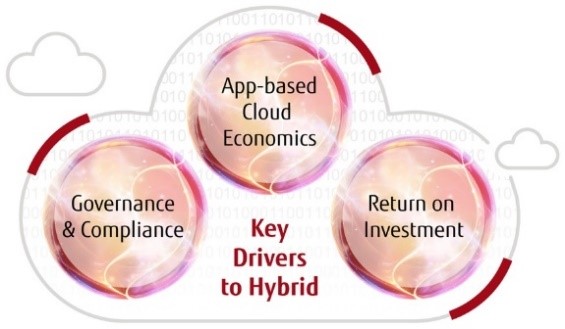
Last year was a litmus test for IT strategies. Many enterprises had to work hard to strengthen their digital resilience. The trick used by CIOs to achieve this was to take the investments needed to cope with the global pandemic and bring them into balance with those planned for the digital future.
Of course, it goes without saying that the cloud is vital in this balancing act. Can anyone really imagine digital transformation without the cloud?
Expectations are high when it comes to potential benefits like rapid time to market, one-click simplicity, fractional IT consumption and continuous innovation to improve the customer experience in real-time.
Whenever customers ask my team how these expectations can be met, we usually recommend hybrid models.
Why are the major cloud players banking on the hybrid cloud?
Cloud players like Netflix, Dropbox, Uber and Airbnb have already adopted hybrid models.
Netflix, for example, still runs the personalized user interface in the cloud, but the video itself is run on-premise. Uber wants new services to keep IT loads under control, while also ensuring GDPR compliance and data sovereignty.
While this is true, it is also vital that organizations operating on-premises benefit by moving some applications to the cloud. Back in 2017, the Royal Bank of Scotland switched to a hybrid model to give its customers uninterrupted services.
IDC's multi-cloud and next-generation infrastructure survey 2020 found that hybrid cloud has now emerged as the preferred cloud-operating model.
83% of European organizations run hybrid cloud – especially because it is the optimal cost model for their IT infrastructure and at the same time allows them to drive innovation.*
What factors ensure the success of hybrid cloud strategies?
Getting the cloud balance right, an IDC InfoBrief, sponsored by Fujitsu and Nutanix, Getting the Cloud Balance Right, January 2021, highlights that businesses that want to bolster their digital resilience while also developing their digital future should focus their attention on digital innovation, digital infrastructure, and data-led value creation.
Taken together, these three aspects interact as a whole, which can ultimately offer speed, intelligence, automation, resilience and efficiency.
Based on their annual multi-cloud and next-generation infrastructure survey, IDC analysts have identified ten key technologies, which are important for success in the cloud.
Enterprises with years of cloud experience and a clearly defined cloud strategy are generally more advanced in using all ten technologies, but focus on the following five to build their digital infrastructure successfully:
- Intelligent security and/or digital trust
- Access to integrated real-time (less than one hour old) data
- Adoption of multi-cloud services (ability to deploy and manage IT services across multiple cloud locations or providers)
- Automation and orchestration
- Programmable infrastructure – software-defined storage (SDS), software-defined networking (SDN), server less, containers, Kubernetes, etc.
Fujitsu’s findings during our interaction with many customers are no different. The projects have revealed that there are three key aspects to be evaluated to ensure successful hybrid models:
1. App-based cloud economics
2. Adherence to data governance and compliance
3. Performance-centric analysis of the return on investment of the overall landscape

Fujitsu leads discussions with customers on this underpinned by our hyper-converged infrastructure offerings – FUJITSU Integrated System PRIMEFLEX.
These solutions feature hybrid IT architectures for the efficient management of workloads from edge to the core data center and even into the cloud, and intrinsically unite the essence of the key technologies so that enterprises can stay ahead of the curve.
With PRIMEFLEX solutions, they can immediately focus on consolidating private and public cloud road maps in order to successfully implement a hybrid and multi-cloud strategy.
Optimal workload allocation in just four steps
What should the roadmap look like to make your cloud vision a reality? Based on customer projects, we have developed the "Right Cloud for the Right Workload" concept, a best-practice approach that guides you to your goals in four steps:
- Start by identifying the challenges facing your business to get an overview of which applications should be retained, rehosted, refactored, rebuilt and replaced.
- The second step is to choose the right architecture based on workload requirements. To do this, the application landscape must be carefully analyzed.
- The third step is selecting the delivery model for each application. Here, control and access to the data distributed across edge, core and cloud are critical factors.
- Finally, the fourth step is to integrate the data architecture across all physical and virtual locations. This step is crucial because successful integration and management of data architecture is key to supporting your business growth and ensuring increased productivity.
In PRIMEFLEX, we seamlessly integrate the best building blocks together with our partners to create holistic solutions that comprehensively meet your requirements. This is exactly what makes our integrated systems probably the fastest track to the "data-driven" enterprise.
Take advantage of Fujitsu’s global technology and service expertise – our “Right Cloud for the Right Workload” concept will let you exploit the potential of your hybrid cloud.
*IDC InfoBrief, sponsored by Fujitsu and Nutanix, Getting the Cloud Balance Right, January 2021











